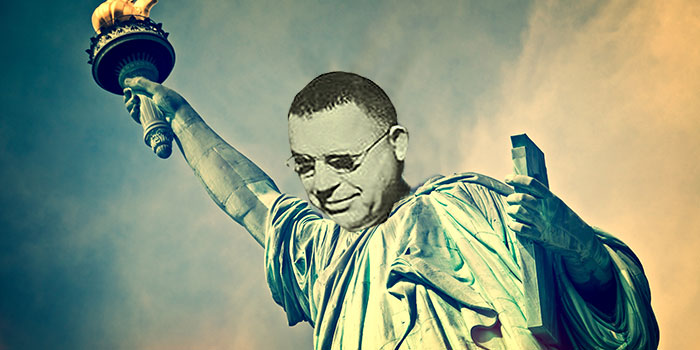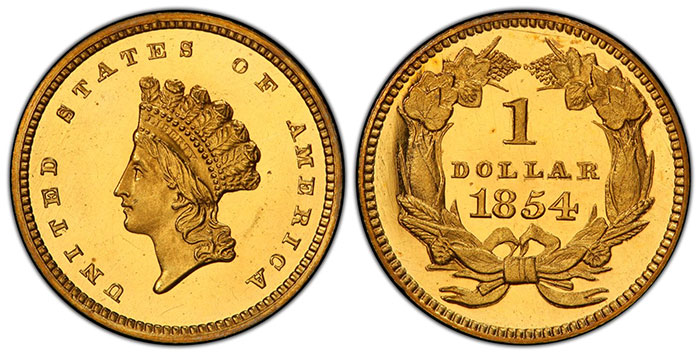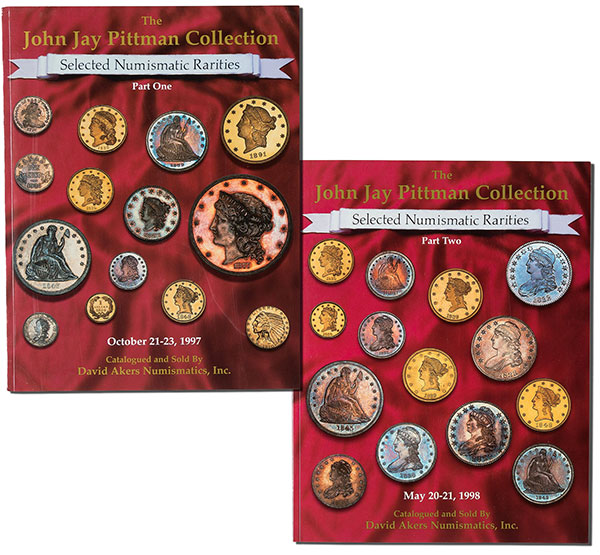
By Ron Guth …..
Once upon a time, long before the COVID pandemic, and well before the internet took much of the business online, rare coin auctions were exciting events held in crowded rooms. Bidding was active, sometimes feverish, and members of the audience scanned the room and craned their necks to see who was bidding on special coins. To combat this unwanted scrutiny, bidders who wished to hide their activity relied on subtle moves that a good auctioneer would catch but which other bidders might not. After all, being too obvious could leave the bidder susceptible to competitors who might run up the price by bidding against them. In some cases, bidders arranged special signals with the auctioneer prior to the sale, including such subtle movements as a flick of a pen or the lifting of an eyebrow. Bidders routinely used small moves to obtain big coins as inexpensively as possible.
Yet for every rule, there’s an exception.

In the case of a very special coin, the rule-breaker was John Jay Pittman, who used a very big move to obtain a very small coin – a Proof 1854 Type Two Gold Dollar.
John Jay Pittman (or “JJP” as he was known by family and friends), loved coins that were both rare and of high quality, especially early Proof coins from the 1800s. JJP began collecting coins in 1943 and he purchased coins in the subsequent three decades from virtually all of the big-name dealers and from most of the major numismatic auction houses. JJP has been described as a man of limited financial means (in fact, he took out a second mortgage on his house to make purchases at the sale of King Farouk’s coins in Egypt in 1954), but considering that his collection brought over $30 million USD at auction, it seems hard to empathize with that image of him. Rather, JJP was a very astute buyer who focused on early American Proof coins when they were much undervalued and underappreciated. In later years, when U.S. coins exceeded his budget, he began to focus on world coins, where he built an equally impressive collection.
One can only imagine what JJP might have accomplished with an unlimited budget.
That he was loved by family and friends is undeniable. David Akers, who sold JJP’s collection in three sales in 1997 and 1998, wrote a glowing tribute to JJP in the first catalog, as did Polly, his daughter. According to Polly, JJP had a photographic memory for coins and faces, and more than one person was impressed that JJP remembered them by name years after a casual encounter. The author had the pleasure of meeting and interacting with JJP in the 1970s.
His was one of those personalities that come along so rarely: beaming, affable, gregarious, a storyteller, and a true believer in — and promoter of — numismatics. In 1998, the author was one of two auctioneers (along with Tom Mulvaney) of the World Coin portion of JJP’s collection, which Polly attended.
It was a once-in-a-lifetime experience.

JJP’s big move, as mentioned above, came in 1956, when he participated in Abe Kosoff’s sale of the Thomas Melish collection. The small Proof 1854 Type II Gold Dollar that JJP stalked measured a diminutive 14.3 millimeters in diameter, but it was an extreme rarity and one of only a few examples known (the roster of four known Proofs is listed at the end of this article). The unusual technique used by JJP to obtain the Proof 1854 Gold Dollar is legendary and was the extreme opposite of the secretive bidding tactics used by other bidders at the time.
Dave Akers recounted the story under Lot 864 in his October 1997 sale catalog of the Pittman Collection, Part I:
“As the lot was called, [JJP] walked to the front of the Florentine Room in the Claypool Hotel where the sale was taking place, turned and faced the crowd, his back to the auctioneer, and held up his arm to bid until the gavel was struck awarding him the lot at $525. During the bidding process, he intently stared at anyone who ‘dared’ to bid against him. He stayed by the podium and repeated the procedure for the next lot … and several subsequent lots … He never wavered and never dropped his arm until he was recognized as the winning bidder in each instance. His actions earned him the nickname ‘The Statue of Liberty’.”
Dave Akers once asked JJP why he did it:
“[H]e told me he acted as he did because he recognized the importance and rarity of the 1854 and 1855 Proofs especially, and felt he might never again have the opportunity to acquire them. As a result, he was ready to buy them at almost any price. However, since he was always on a restricted budget, he didn’t want the prices to get out of hand, and so he felt he would have the best chance to be successful if he were able to convince other prospective bidders to drop out of the bidding early, once they had observed his resolve.”
JP’s shock-and-awe technique worked out well for him. He was able to add the Proof 1854 Type Two Gold Dollar to his collection, along with Proof 1855, 1856, and 1857 Gold Dollars, and other coins. It takes a steely resolve to do what JJP did – the few bidders who have attempted to duplicate JJP’s technique in later years have found their arms get increasingly heavy as the price climbs higher and higher. Today, the anonymity of online bidding has rendered irrelevant the secretive bidding and JJP’s “Statue of Liberty” technique.
What happened with JJP’s Proof 1854 Type Two Gold Dollar? In 1997, it realized $176,000, an amazing 335 times JJP’s original purchase price. In 2009, the coin sold for $218,500 and it now resides in the D.L. Hansen Collection (the mega-collector who is seeking to duplicate Louis Eliasberg, Sr.’s feat of completing a set of all United States coins).
JJP will always be remembered for the incredible collection he built and for the big, bold moves he took to acquire the coins he wanted. JJP is no longer with us, but his “Statue of Liberty” move is the stuff of legends. May you rest in peace, Mr. Pittman.
A Roster of the Known Proof 1854 Type Two Gold Dollars
- PCGS PR64DCAM
Col. Mendes I. Cohen Collection – Edward Cogan 1/1875:240 – Lorin G. Parmelee Collection – New York Coin & Stamp Co. 6/1890:1244 (as Raw Sharp, perfect proof), $5.00 – William H. Woodin Collection (per S.H. Chapman’s priced/named catalog on the Newman Numismatic Portal) – Thomas Elder 3/1911:851, $65.00 – Virgil Brand Collection (Journal #57033) – Thomas Melish Collection – Abe Kosoff 4/1956:1742, $525.00 – John Jay Pittman Collection, Part I – David Akers 10/1997:864 (as Raw Proof-64), $176,000.00 – Bowers & Merena 3/2009:1455 (as PCGS PR64DCAM), $218,500.00 – D.L. Hansen Collection, via Jeff Garrett (as PCGS PR64+DCAM 06648642)
- NGC PR65UCAM
Harold P. Newlin Collection, sold privately on 10/31/1884 – Robert Garrett Collection – T. Harrison Garrett Collection – Robert Garrett Collection – John Work Garrett Collection – Johns Hopkins University Collection, Part I – Bowers & Ruddy 11/1979:403 (as Raw Brilliant Proof), $90,000.00 – Stack’s “Auction ‘83” 7/1983:761 (as Raw Choice Brilliant Proof), not sold – Superior 9/1997:2846 (as PCGS PR64 08441806), not sold
- Raw Proof
J. Colvin Randall Estate – J.P. Morgan Collection, donated in 1908 – American Numismatic Society Collection (Identifier 1908.93.241)
- Raw PR60, cleaned (per Jeff Garrett)
National Numismatic Collection at the Smithsonian Institution
* * *
About Ron Guth
Ron Guth is the Chief Investigator at the Numismatic Detective Agency (www.numismaticdetectives.com), where he researches provenances on Condition Census-quality U.S. coins. He has been active in numismatics for 55 years as a collector, researcher, auctioneer, and professional dealer. He is the author or co-author of several best-selling numismatic books, including Coin Collecting For Dummies, The 100 Greatest U.S. Coins, and The Encyclopedia of United States Gold Coins.
In 1999, he created CoinFacts (now PCGS CoinFacts). In 2014, he was named the American Numismatic Association (ANA) Numismatist of the Year. In 2021, he was named by Coin World as one of the Top Ten Most Influential Numismatists of the 1960-2020 period.




